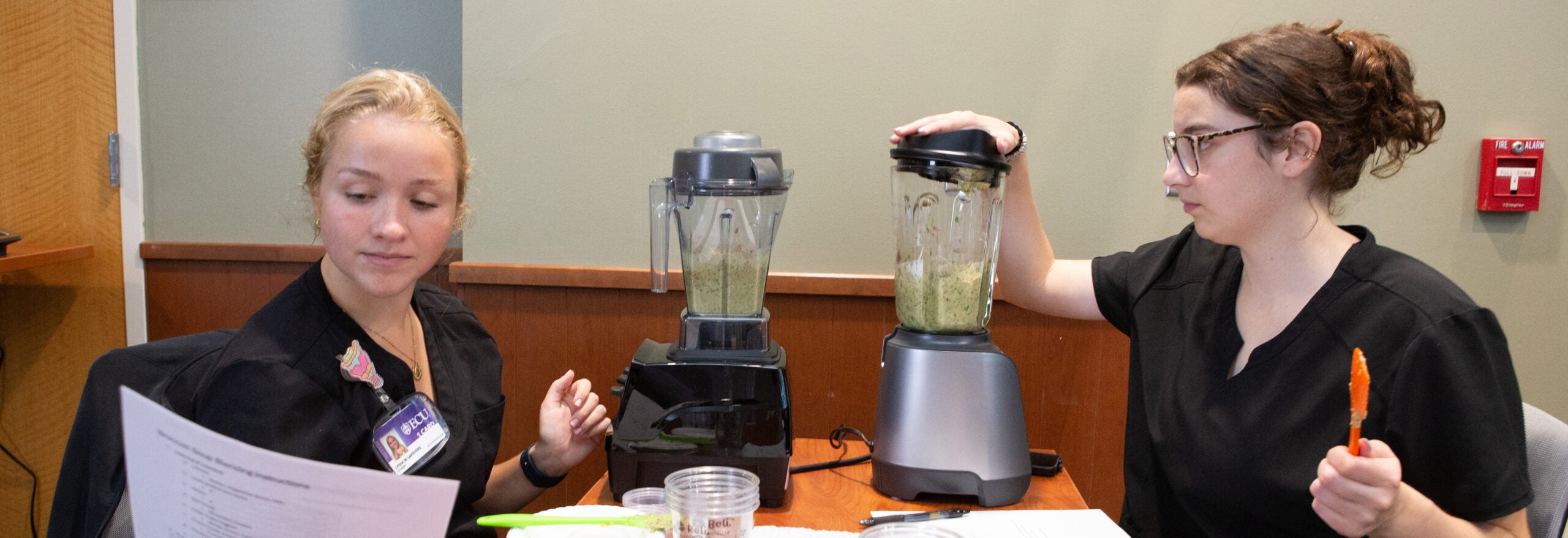Speech student blends science, compassion for dysphagia study
An undergraduate student in East Carolina University’s speech language pathology program is offering hope to those with dysphagia through a novel research project — testing kitchen blenders.
Hannah Shook will start her junior year in the fall. The Newton native spent her summers in Pitt County with an aunt who is a Pirate.
Joining ECU’s speech language pathology program was always her goal.
“I had an internship in the eighth grade, and I got to hear a patient say her first word and that kind of like changed everything,” Shook said. The patient had been non-verbal her whole life, and hard work with a speech language pathologist gave her the tools to say “bubbles.”
Shook wants to know which machines are best for blending food for patients with dysphagia, the medical term for difficulty swallowing. She was first exposed to swallowing difficulties after experiences working with patients recovering from head and neck cancers.
Funding for the research came from the university’s Undergraduate Research and Creativity Award program that underwrites the academic activity of burgeoning scholars.
A New Line of Inquiry
Dr. Deirdre Larsen, an assistant professor of speech pathology in the College of Allied Health Sciences and Shook’s faculty mentor, never planned to be a speech language pathologist. But after years of exploring possible careers and an opportunity to shadow a SLP, she jumped at the opportunity to help others with producing sound, and later swallowing.
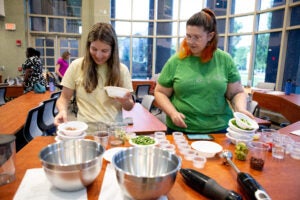
Speech language pathology students Hannah Shook, right, and Samantha Smith, prepare food for a study of the effectiveness of blenders.
The Alabama native completed her master’s and doctoral degrees at Louisiana State University. Larsen came to ECU at the suggestion of one of her mentors who had visited Greenville to give a lecture and heard of a job opening.
“I didn’t apply anywhere else,” Larsen said.
Her intent was to start a pediatric feeding program at ECU, but that proved difficult. So, she shifted her service and research focus to a specialty she was exposed to in her Ph.D. work.
Not long after arriving in Greenville in 2022, Larsen started the Head and Neck Cancer Clinic, which offers therapy for those with difficulty swallowing due to past or ongoing cancer treatment. The clinic also offers an interprofessional support group to help patients deal with the emotional challenges can come with the upheaval of radiation or surgical treatments.
“The patients I work with, whether they have head and neck cancer or not, tend to have some type of dietary modification where they either have to chop or blend their foods, or can’t eat foods at all and they may have to thicken liquid. So, it’s a pretty limited diet,” Larsen said.
Teaching undergraduate and graduate students about dysphagia has always been difficult because there are few, if any, clinical placements for students to learn about swallowing difficulties.
“When I started this, maybe four to six of our students might get dysphagia experience before graduation in a formal way. I have seven this summer who are getting clinical experience and three of them have changed their minds completely about dysphagia,” Larsen said.
One of the patients Larsen sees at the clinic has been “an encyclopedia of what to do in terms of eating and drinking” due to living with a childhood head and neck cancer that was successfully treated with radiation but saddled her with speech and swallowing issues. Her role in the blender research project can’t be understated, Larsen said.
“What we were trying to figure out was if we had some of her basic recipes that we knew that were challenging ingredient-wise for the blenders, could we get high-quality purees without the chunks, without the pieces — and without the cost,” Larsen said.
Food as a Cultural Imperative
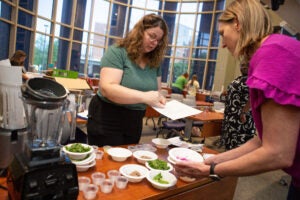
Dr. Deirdre Larsen and Emily Brewer, faculty members in the Department of Communication Sciences and Disorders, check the ingredients in a taco salad to be blended in their research study.
Food is a cultural adhesive. Sharing meals creates community, and when those ties of connection are severed, patients tend to withdraw.
Shook said there is a paradox for patients who have swallowing difficulties, particularly those with head and neck cancers: they need extra nutrition to get them through their ordeal, but the act of eating is difficult, and social isolation removes them from opportunities to bond over shared meals.
“We go out to eat with our families and friends, or we invite others over and end up spending time in the kitchen,” Shook said. “For people with dietary differences, making sure they have something to eat kind of neutralizes everything.”
Being able to share the same foods with loved ones and friends, Larsen said, can help to rebuild a sense of self after a medical adversity. One of her patients was the center of her family’s gatherings, taking the lead on cooking for holidays, until cancer treatment made eating difficult.
“If we can give even a piece of that back, that’s a very big thing for them,” Larsen said.
Student-Led Research
But why are SLPs even involved in swallowing, when food isn’t integral to speech or language? Larsen said she get that question a lot from her patients and she has two responses: SLPs are experts in the muscles of the head and neck and, well, initially none of the other medical specialties had stepped up.
“We are trained in the muscles of the head and the neck in terms of speech; all we’re doing is changing the function of those structures with swallowing,” Larsen said. “Even within speech pathology, only about 13% focus on swallowing.”
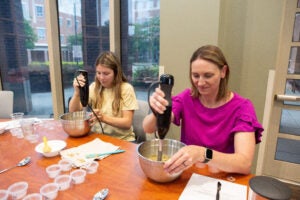
CSDI faculty member Emily Brewer, right, and speech language pathology student Samantha Smith use immersion blenders to mix food during a research study.
High-performance consumer-grade blenders are the gold standard for reducing chunky, difficult to swallow foods into a variety of consistencies and textures, but they are a costly investment for many. For the study, Shook and Larsen visited a local department store and purchased a variety of blenders to test — from personal-sized models with the capacity of a drinking glass and immersion blenders, to larger capacity devices found on the kitchen counters of many homes.
“It turns out the high-performance blender we tested is where it’s at” for reaching finer granularities, Larsen said.
Prior to this research project, Larsen said her advice to her patients was to cook like they always had and put the food into the blender — no big deal. But one day a patient switched a lightbulb on for her — just blending the food changed everything, especially texture.
Larsen said many people don’t consider the texture of food until they have to and until 2022, there weren’t standards for the textures and fineness at which food should be blended to be safe for those with challenges swallowing. In 2017 the International Dysphagia Diet Standardization Initiative established an eight-level system of grading the extent to which foods are blended, but it wasn’t adopted in the U.S. until 2022.
Even foods that have traditionally been included in a liquid diet, like gelatins, aren’t really suitable for those on a truly liquid diet, according to the IDDSI standards, Larsen said.
“We prepared the exact same recipe on every device and blended them for the exact same time. We even gave two of the blenders a little extra time and a little extra liquid,” she said.
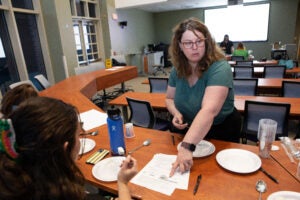
Dr. Deirdre Larsen explains the different consistencies of blended food on the International Dysphagia Diet Standardization Initiative scale to speech language pathology students during a blender research study.
Larsen said her long-term goal is to get the higher quality blenders recognized by health insurance companies as a medical device. To get the cost offset for those in need would “be a huge deal for a lot of people.”
The morning of the testing, Shook enlisted about a dozen fellow students and faculty members to prepare meals to be blended and to serve as blind testers of two recipes — a taco salad and broccoli and cheese soup — used to put the blenders through their paces.
Shook said the initial findings from the research were obvious. Most of the blenders they tested struggled to achieve consistent results that meet the higher end of the IDDSI standards.
“I had really high hopes, but after one blender completely failed, one overheated and the others needing so much more support to get half of what the high-end blender did …” Shook said. “It was unfortunate.”
Larsen and Shook are eyeing several clinical speech language pathology journals to hopefully publish the results of their research, to help their field better understand the capabilities of different blenders.
Shook said being in a leadership role for the study was scary. She didn’t want to get anything wrong, but when there were hiccups the team recovered quickly. Shook said she was amazed to be in her second year of college and producing meaningful research.
“I think I have a little bit of an upper hand right now with my research and I’m incredibly grateful,” Shook said.
